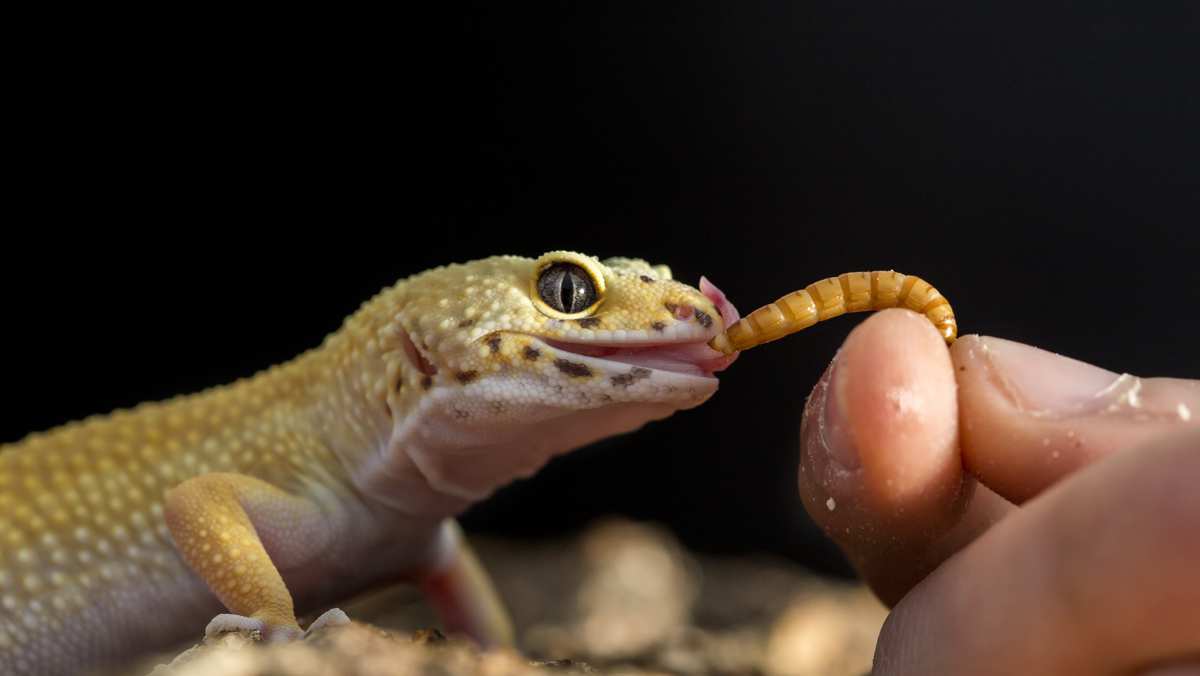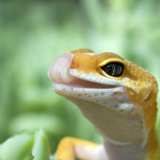
- Most popular insect
- Smaller crickets are best


Leopard geckos are insectivores, which means they only eat insects. This makes them easy to feed, but you still need to follow a diet to make sure they stay healthy. This page will go over how to feed your leopard gecko and make sure their diet is healthy and nutritious.
Leopard geckos will eat anything that moves or wiggles in front of them. You should only feed your gecko live insects (most leopard geckos won't eat dead prey). It is difficult to overfeed leopard geckos, since they store their excess fat in their tail, but it is possible. So if you feel your leo is gaining a lot of unnecessary weight, you may want to cut back on their feedings or remove any fatty insects from their diet.
You should feed your leopard gecko late in the day or early in the evening, since that is generally the time they start hunting in nature. There is no ideal routine to feeding leopard geckos since each gecko has different eating habits. Below are the most common feeding schedules among leopard gecko owners:
Geckos that tend to overeatFeed them a set amount predetermined by you to reduce excessive eating and prevent them from gaining additional weight.
Geckos that are a healthy weightGeckos that are active and already at a healthy weight can be fed as much as they can eat in a 15-20 minute period.
Geckos that are stubborn eatersIf your gecko is a picky eater you should feed them normally, but leave a food dish with worms available in their tank so they can eat later if they get hungry.
Leopard geckos have been known to change food preferences as they get older, so your gecko may love crickets one week and hate them the next. Because of this many owners will mix up their diet with a combination of crickets, worms, and other insects to keep some variation in what they eat.
When feeding your leopard gecko you will want to put any worms into a feeding bowl or a shallow dish that they can easily reach. You should put the crickets in their tank and place them as close to your gecko as possible so he/she will see the prey. Some owners will only place 2 crickets in the leopard gecko enclosure at a time because it can be difficult to re-catch the crickets if your leo decides they aren't hungry after all. If you have remaining crickets in the tank and your leo is done eating, you should remove the crickets. Crickets will molt, crawl onto your gecko, and will sometimes bite the tip of your gecko's tail so it's best to remove them from the tank to save them for another feeding.
Insects can be too big for your leopard gecko to safely digest, so it's up to you to make sure they are the correct size before feeding. The general rule of thumb is to not feed your gecko any insects that are longer (in length) than the space between their eyes.
The below table shows estimated cricket sizes by gecko age:
Most leos will stop eating when they're full, but others will try to keep eating. If your gecko seems like he/she is eating too much you shouldn't overfeed your leopard gecko because it can cause him/her to gain unnecessary weight and it can lead to them regurgitating their food. If you're concerned your leopard gecko is eating too much you can tell by how large they are. Like people, leopard geckos which are overweight will start to develop are large stomach and will start to store fat in other areas of their body (besides their tail).
Here are a few general rules regarding overweight geckos:
If you suspect you are overfeeding your leo, you should cut back on the amount of food your offer and/or remove fatty insects from the diet until they are at a healthy weight.
Your leopard gecko's feeding schedule depends on their age and health. Younger leopard geckos will need to be fed every day while healthy adult leopard geckos (one year or older) should be fed once every other day. If you have a sick or weak leopard gecko they should be fed every day until they have grown in strength or are back to a normal healthy size.
Leopard geckos will eat just about any bug that crawls in front of them. However, not all insects are safe or healthy for your leopard gecko to eat. Below is a list of the most popular insects that owners will feed their leopard gecko.
Crickets are probably the most popular insect fed to leopard geckos. They are healthy and are easy to purchase. When feeding crickets to your leopard gecko you should make sure that they are not too large to digest.
Mealworms are another leopard dragon staple food. They are easy to get and are healthy. When feeding mealworms you should choose ones that have freshly molted so they are easier to digest.
Waxworms should only be fed to leopard geckos occasionally as treats (once or twice per week max) because they are high in fat and can become addictive to some geckos.
Silkworms are healthy for leopard geckos and are great insects to use to add a variation to their diet. They can be expensive and usually don't live longer than a few weeks so order them in small quantities.
Dubia roaches are healthy and tasty for leopard geckos. They are also very easy to breed and many owners will create the own Dubia roach colony to save money.


Below are some bugs that are unhealthy or toxic to leopard geckos and should never be fed to any leo.
If the insect can glow or light-up in the dark, then you should not feed it to your leopard gecko. The chemical that makes these bugs glow is highly toxic to geckos and even one bug can contain a lethal amount of toxins. There is no known treatment because there has been no evidence of a gecko surviving long enough to reach a vet.
You should never feed your leopard gecko any bugs that you've caught yourself. The reason is because wild insects may contain parasites that can infect your gecko if eaten. Besides parasites, many bugs will also contain trace amounts of pesticides which can be toxic for geckos.
Your leopard gecko will need vitamins and minerals to remain healthy. The best way to ensure your gecko gets enough vitamins and minerals is by gut loading and dusting the insects you're feeding him/her.
Gut LoadingGut loading is where you feed the bugs nutritious food before you give them to your leopard gecko to eat. There are many cricket feeds available that are perfect for gut loading. It is recommended to gut load your insects 12 hours before feeding them to your leopard gecko. This way the insect will still have the nutritious food in their body.
If you're using mealworms you should gut load them with carrots 24 hours before feeding. You can also place some of the cricket gut loading food into the dish containing the mealworms so they will eat some of that too. Some owners that leave mealworms in their leopard gecko's tank all day will leave food in the dish for the mealworms to eat. This way the mealworm is gut loaded whenever the gecko decides to eat them.
DustingDusting is where you purchase a dusting powder (such as a calcium and vitamin D3 supplement) and dust the feeder insects in the powder before your leopard gecko eats them. Most owners will dust their insects by placing the insects and a small amount of dusting powder in glass jar and gently shaking it until the bugs are lightly coated with the powder. After you dust the insects you should immediately feed them to your leo, otherwise the feeder insects may clean the powder off themselves.

Learn how to read a leopard gecko's body language and learn what certain behavior means.
Go to the Previous Page